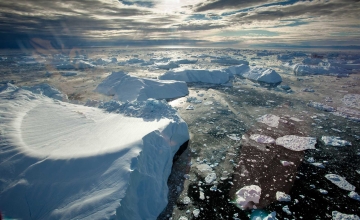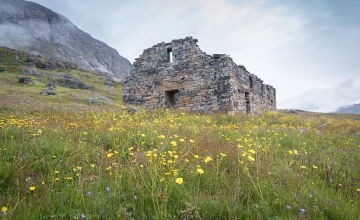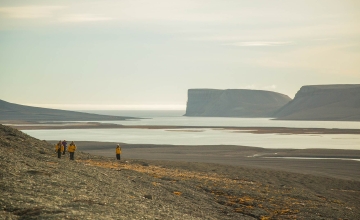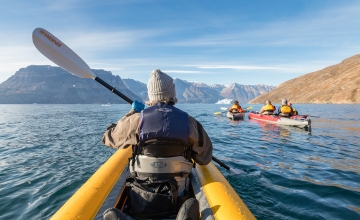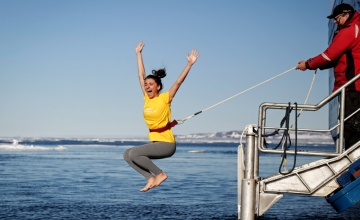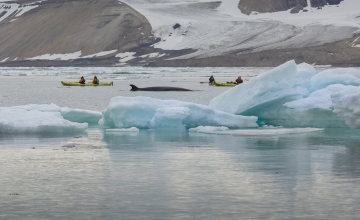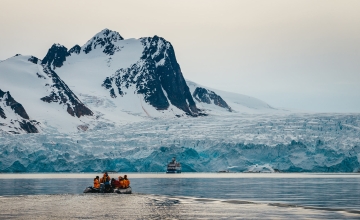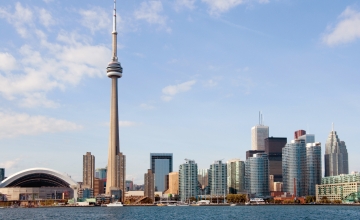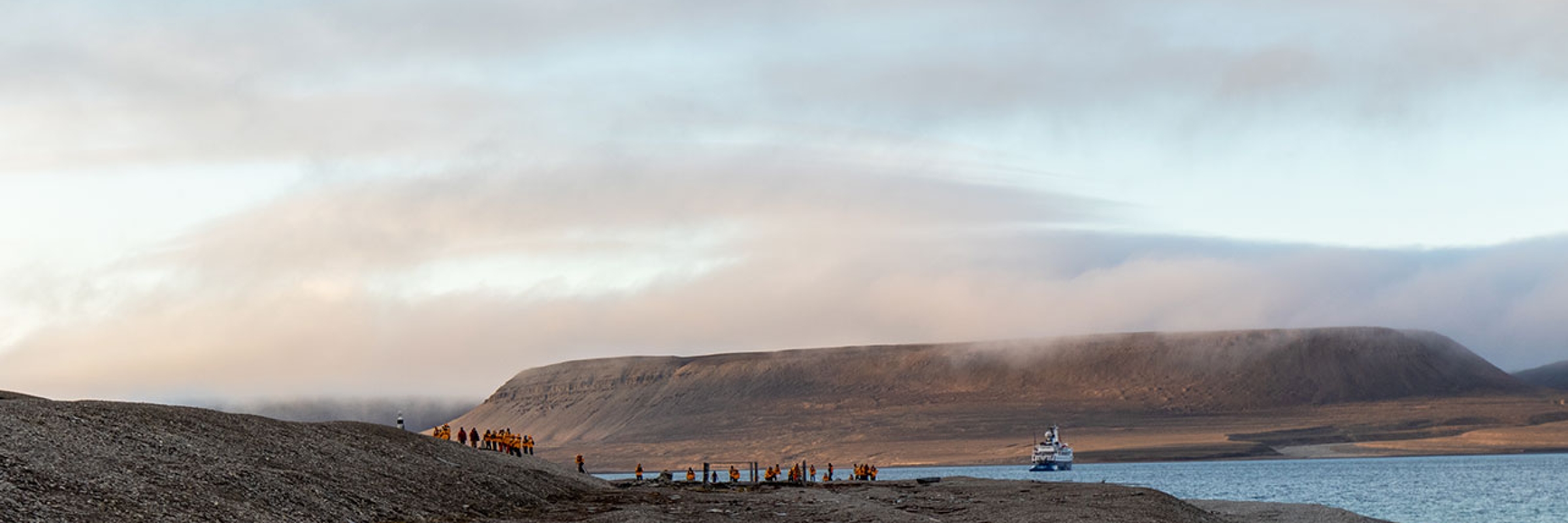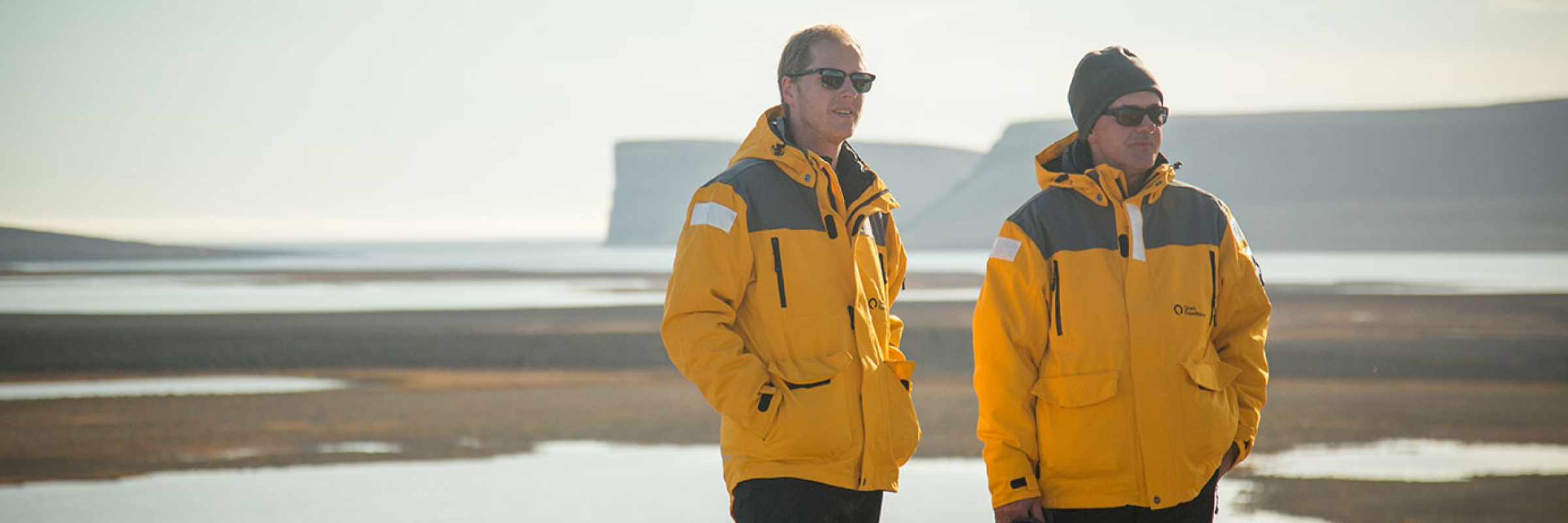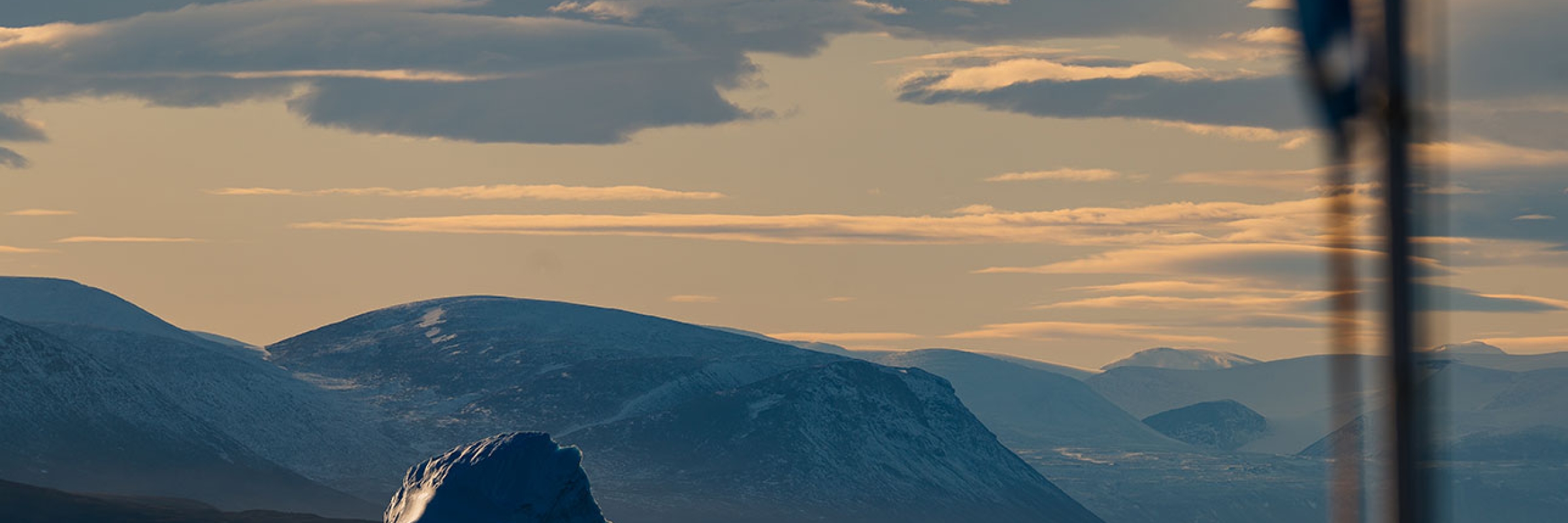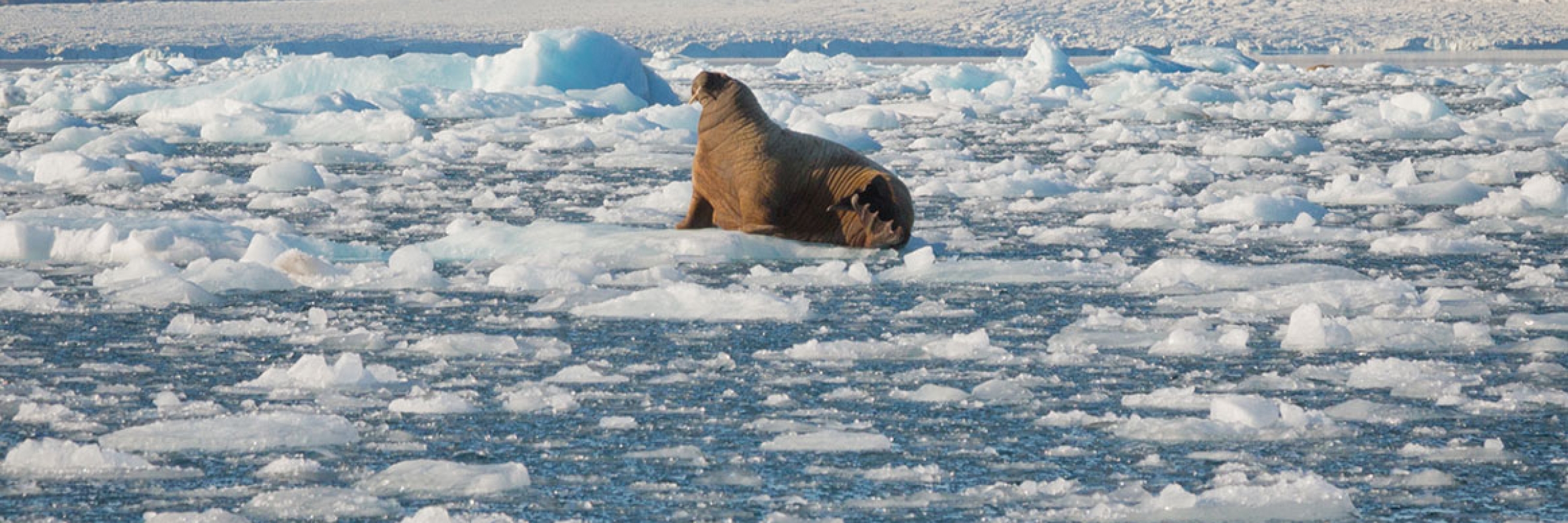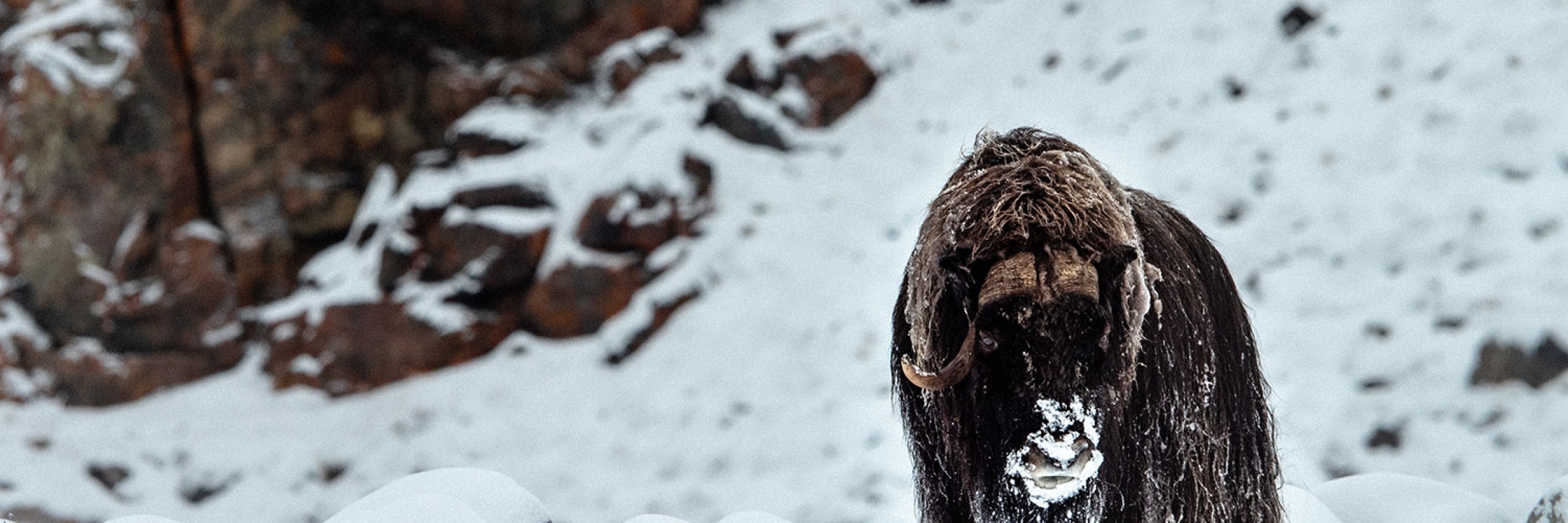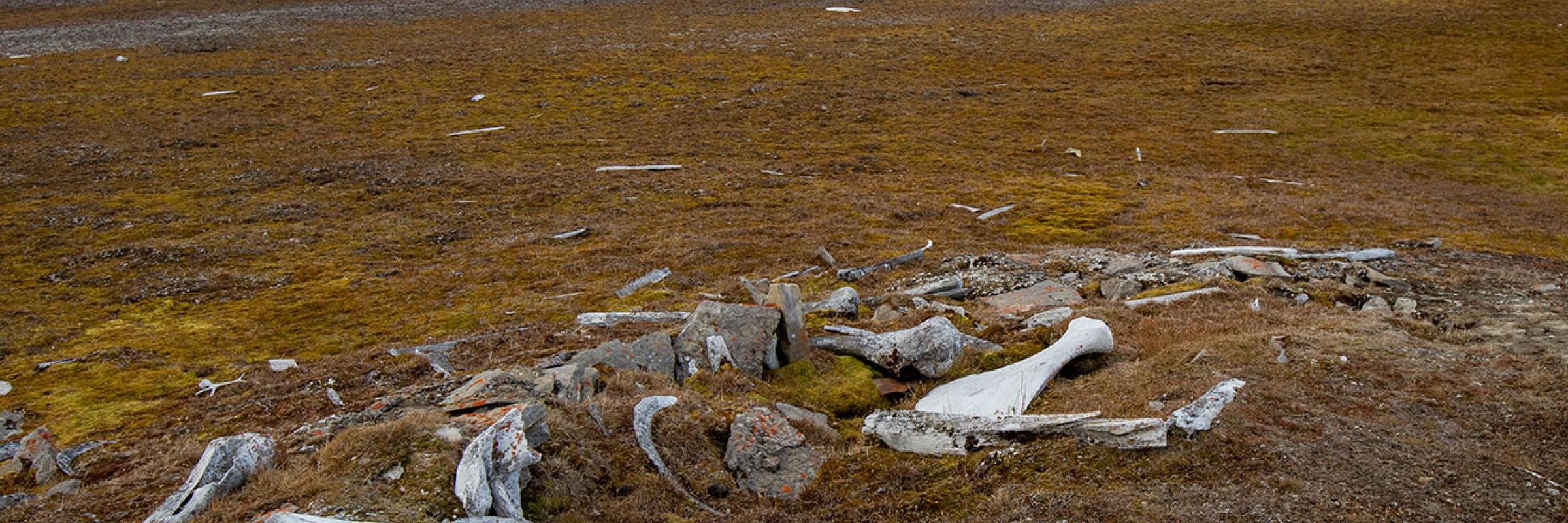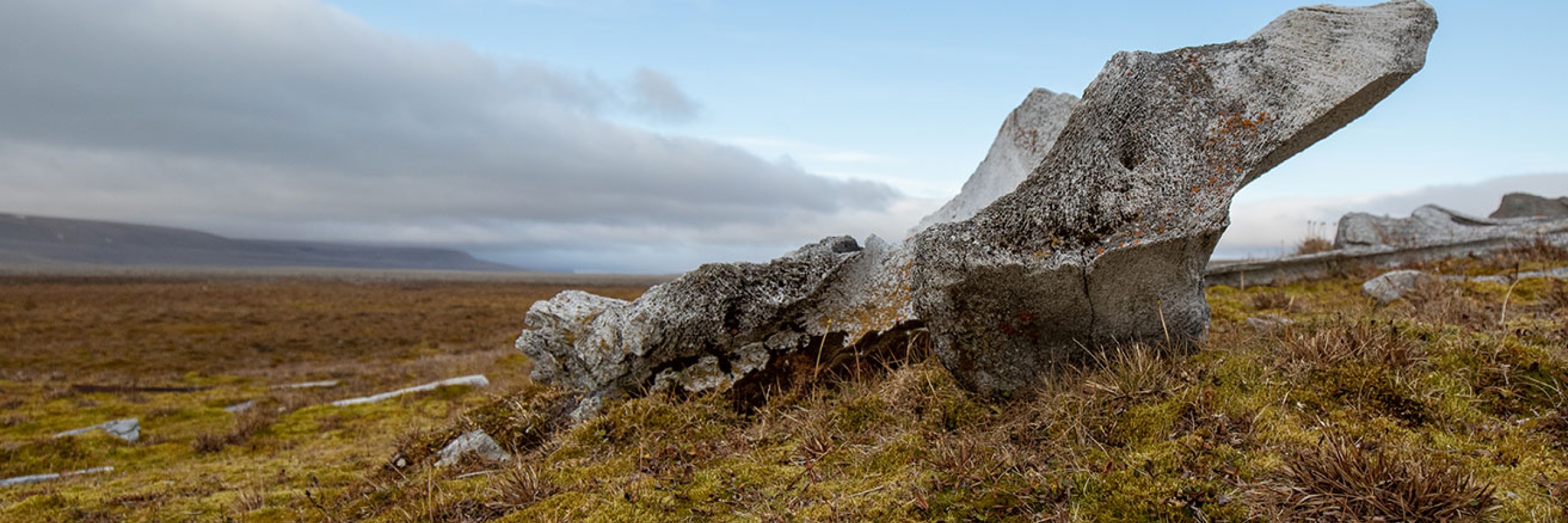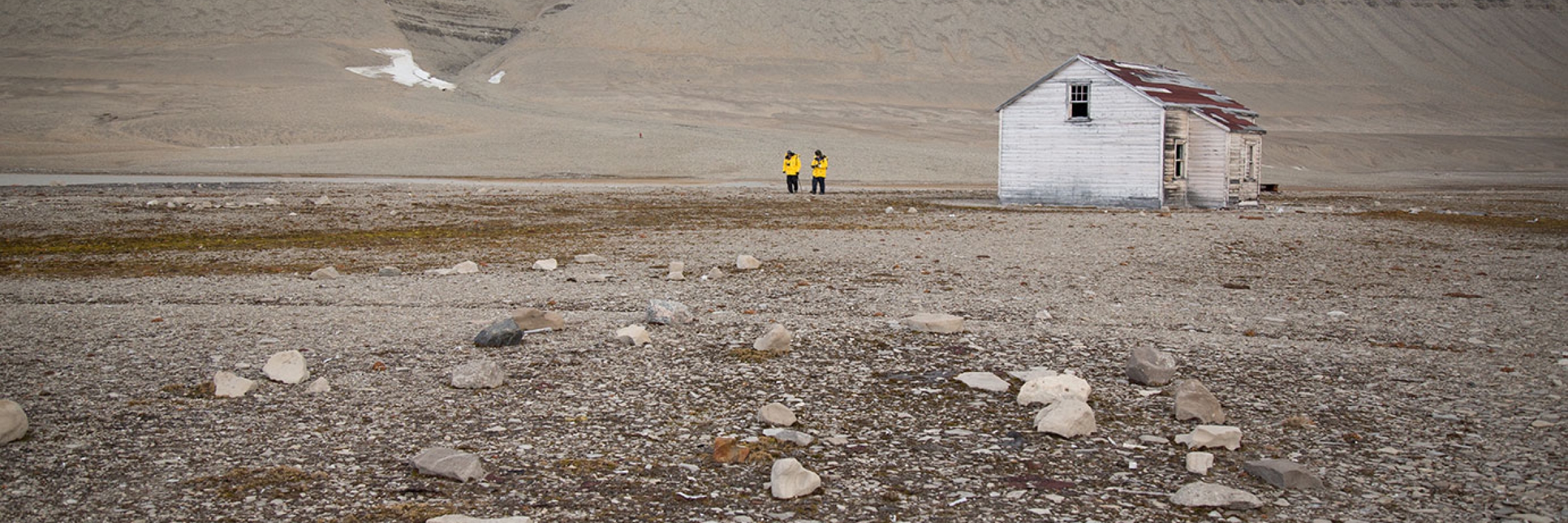Your Arctic expedition begins in Toronto. Explore this vibrant city on your own before you spend the night enjoying the comforts and amenities of your designated hotel.
Canada’s Remote Arctic: Northwest Passage to Ellesmere and Axel Heiberg Islands
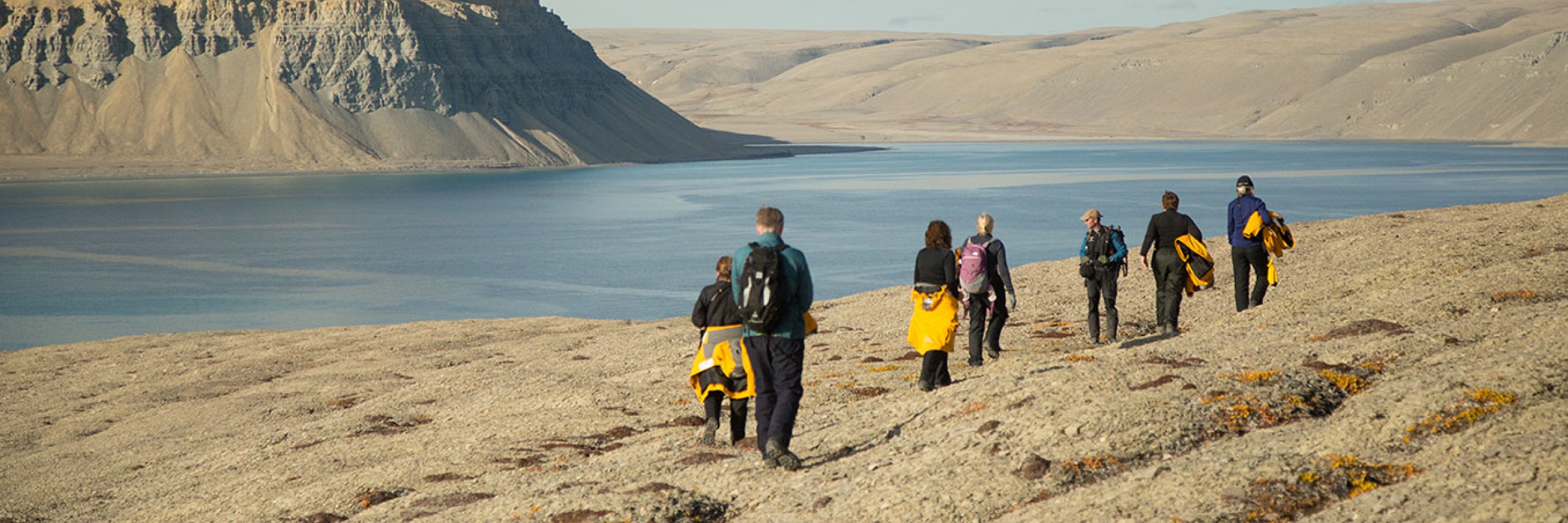
Here, at the top of the world, nature has created unique wonders in astonishing variety. Our game-changing new expedition vessel Ultramarine, equipped with two twin-engine helicopters and 20 quick-launching Zodiacs, enables you to explore this breathtaking environment from brand new perspectives. You’ll experience the same sense of wonder felt by early explorers as they navigated the region’s formidable bays, inlets and channels.
On this exciting itinerary, we follow the natural guides of sea and ice to showcase the region’s cultural, historic and geographic treasures, aiming to approach the farthest stretches of this rugged, rarely visited landscape. Ultramarine’s unprecedented range of adventure options, including activities such as helicopter flightseeing, gives you an unrivalled polar experience. You’ll be able to view the magnificent wildlife that make their home in this forbidding region: sea mammals, polar bears, muskox, and possibly even the elusive arctic wolf. From soaring cliffs to mummified forests, spectacular glacial formations to stunning alpine vistas, expansive waterways to sheltered shores, Canada’s Remote Arctic provides the definitive experience of a mysterious, magical region few ever get to see.
- Follow the footsteps of polar explorers and experience highlights of the Canadian Arctic
- Search for iconic Arctic wildlife such as polar bears and muskox
- Enjoy flightseeing and heli landings with Ultramarine’s two onboard helicopters
- Cruise in a Zodiac to get up close to glaciers, fjords, icebergs and more
- Learn about the environment and wildlife from our onboard polar experts
行程
Day 1 — Arrive in Toronto, Canada
Day 2 — Fly to Resolute and Embark
This morning, board your charter flight to Resolute, Nunavut. Upon arrival, you may have a chance to check out this small hamlet on foot before being transferred to your ship via Zodiac or helicopter (depending on ship location and weather conditions).
Days 3 to 10 — Exploring Canada’s High Arctic
Cruising around the remote islands of the Canadian High Arctic aboard Ultramarine, the newest ship in our fleet, you’ll navigate the same icy inlets, channels and bays that fascinated legendary explorers of long ago. Designed to give polar adventurers unprecedented access to the hardestto- reach places on the planet—and equipped with two onboard twinengine helicopters for unparalleled access to areas only Quark Expeditions can bring you—this one-of-a-kind ship will take you beyond the familiar in polar exploration. Throughout your journey, your Expedition Team will keep an eye toward immersing you in the best the Arctic has to offer, including reaching Canada’s most northerly islands: Axel Heiberg Island and the rarely visited Ellesmere Island, at the top of the world.
Remember that no two polar voyages are alike, since each expedition presents new opportunities and different weather and ice conditions. While this voyage has no fixed itinerary, our objective is to visit as many of the incredible highlights the season has to offer, using our extensive expertise to give you the best experience. Each day, your highly skilled Expedition Team will read the conditions and choose the best course to set, but despite their knowledge of these areas, each visit brings something new to discover. That said, our expeditions will have some elements in common, including daily Zodiac cruising, land excursions, a robust education program, a community visit and wildlife viewing opportunities. And thanks to our onboard helicopters, you’ll also discover the ultimate polar expedition experience: While polar landscapes are spectacular from the sea and on land, the view from the air is uniquely stunning. Conditions permitting, you’ll enjoy ultra-immersive activities like flightseeing (short sightseeing flights around your ship and surrounding areas) and helilandings (flying to places we could not otherwise access for shore excursions), two breathtaking options that are unique to Ultramarine and give you an aweinspiring polar experience like no other.
While this waterway is known to European cultures as the Northwest Passage, this area has nurtured and sustained the Inuit and their predecessors who have called these shores home for almost 5,000 years. Moving through these remote landscapes you will be traveling through the ancestral homelands of this ancient culture, illuminated in person by Inuit guides onboard and ashore. Nunavut is an Inuktitut word meaning “our land” and the Nunavummiut (the people of Nunavut) are renowned for their incredible resourcefulness, hospitality, good humor, and a deep knowledge of the land and animals that has allowed them to thrive in the far north for millennia.
Ultimately, your Expedition Team will keep its eye northward, hoping to follow in the footsteps of the lucky few polar adventurers who have transited through the famous Hell Gate to reach the top of the world, the spectacular Ellesmere Island. If conditions are right, the soaring, ominous snow-capped peaks of this polar desert will come into focus as we approach. The northernmost island in the Canadian Arctic Archipelago, Ellesmere is one of the most remote places on the planet, a land of deep fjords, jagged mountains and massive ice shelves. If we’re fortunate enough to reach here, you will be among the few polar explorers to do so.
One of this expedition’s objectives, weather and ice conditions allowing, is to visit the famous fossil forest on Axel Heiberg Island, Canada’s second most northerly island. Dating back more than 30 million years, the large mummified stumps were discovered in 1985 after erosion swept them clean. The original forest that was here flourished, with some trees reaching as high as 115 feet (35 meters) and growing for 500 to 1,000 years. Birders will want to have their binoculars and cameras at the ready, as the island also affords opportunities for sightings of snow buntings, ptarmigans, jaegers and arctic terns, among others.
Wildlife sightings are almost guaranteed, as many of the areas we hope to explore are home to a surprising number of birds and mammals that thrive in this challenging environment. You may see polar bears, muskoxen and several bird species, such as gyrfalcons and dovekies (little auks). If you’re lucky, you may even spot the elusive narwhal or arctic wolf, though sightings of these iconic creatures in the wild are rare, even in these areas where we have the highest chances of encountering them.
Coburg Island, for instance, is a wildlife reserve for such birds as snowy owls and peregrine falcons, while the impressive vertical cliffs of Prince Leopold Island are dotted with nesting seabirds like northern fulmars and black guillemots. The sheltered shores and steep cliffs of Arctic Bay, a hamlet located off of Admiralty Inlet, provide an ideal nesting habitat for various High Arctic birds such as snow geese, thick-billed murres (Brünnich’s guillemots) and kittiwakes. The region has been occupied by Inuit and Thule cultures for almost 5,000 years. This community is an ideal spot to go ashore and learn more about the Inuit culture, sampling the local cuisine and mingling with artists, perhaps picking up carvings or other handicrafts as a memento of your polar adventure.
Devon Island is another possible locale for wildlife encounters, as walrus, polar bears and muskoxen inhabit the area, which is also the location of the remains of a Royal Canadian Mounted Police outpost, established at Dundas Harbour in 1924 to curb foreign whaling and other activities. Nearby is a small cemetery, one of Canada’s most northerly, still maintained by the RCMP to this day. Another exciting excursion your Expedition Team might offer, conditions permitting, is the opportunity to fly up to explore the Devon ice cap, one of the largest in the Canadian Arctic. History buffs will also be intrigued by the chance to visit an abandoned Hudson’s Bay Company trading post at Fort Ross, at the southern end of Somerset Island, and pay their respects to the ill-fated Franklin expedition of 1845–46 at the gravesite of three crew members on Beechey Island, one of Canada’s most significant Arctic exploration sites.
You may have the opportunity to cruise in a Zodiac along the face of an active glacier near Croker Bay and possibly even witness the wonders of calving ice, at a safe distance. Listen closely for the steady crackle and deep roars as slabs of ice break off and crash into the water below. You’ll also want to be on the lookout for the walrus that are often seen in the area.
There is no shortage of natural beauty, wildlife and history in Canada’s High Arctic. Each day, you’ll discover something new and inspiring, whether it is admiration of the tundra flora to survive the extremely rugged environment, a rare bird species soaring overhead, a polar bear on the hunt in its natural habitat, or the ancient remains of a Thule dwelling, predecessors of the Inuit who live here today.
Day 11 — Disembark in Resolute, Canada and Fly to Toronto
After disembarking in Resolute, you’ll be transferred to your charter flight to Toronto, where you’ll spend the night at your included hotel.
Day 12 — Depart Toronto
Today, make your way to the airport to catch your homeward flights, or spend the day exploring this fascinating city.
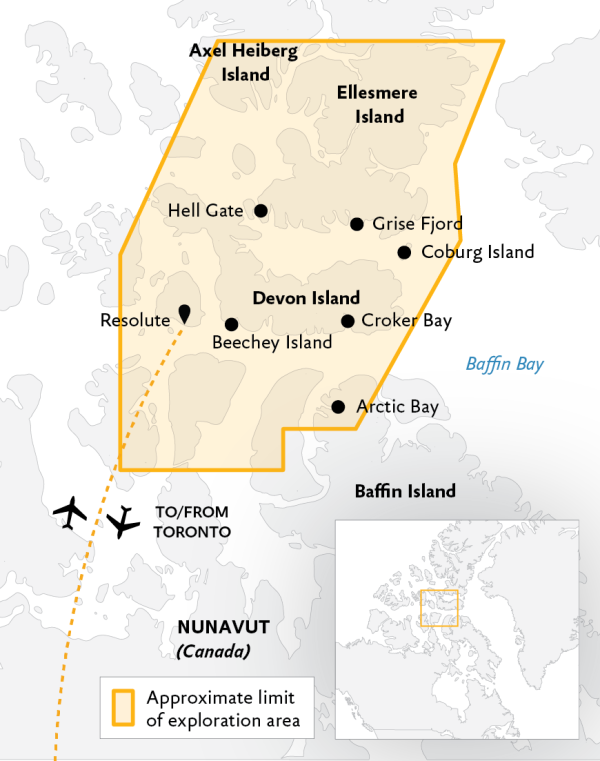
Day 1 — Arrive in Toronto, Canada
Your Arctic expedition begins in Toronto. Explore this vibrant city on your own before you spend the night enjoying the comforts and amenities of your designated hotel.
Day 2 — Fly to Resolute and Embark
This morning, board your charter flight to Resolute, Nunavut. Upon arrival, you may have a chance to check out this small hamlet on foot before being transferred to your ship via Zodiac or helicopter (depending on ship location and weather conditions).
Days 3 to 10 — Exploring Canada’s High Arctic
Cruising around the remote islands of the Canadian High Arctic aboard Ultramarine, the newest ship in our fleet, you’ll navigate the same icy inlets, channels and bays that fascinated legendary explorers of long ago. Designed to give polar adventurers unprecedented access to the hardest-to-reach places on the planet—and equipped with two onboard twin-engine helicopters for unparalleled access to areas only Quark Expeditions can bring you—this one-of-a-kind ship will take you beyond the familiar in polar exploration. Throughout your journey, your Expedition Team will keep an eye toward immersing you in the best the Arctic has to offer, including reaching Canada’s most northerly islands: Axel Heiberg Island and the rarely visited Ellesmere Island, at the top of the world.
Remember that no two polar voyages are alike, since each expedition presents new opportunities and different weather and ice conditions. While this voyage has no fixed itinerary, our objective is to visit as many of the incredible highlights the season has to offer, using our extensive expertise to give you the best experience. Each day, your highly skilled Expedition Team will read the conditions and choose the best course to set, but despite their knowledge of these areas, each visit brings something new to discover. That said, our expeditions will have some elements in common, including daily Zodiac cruising, land excursions, a robust education program, a community visit and wildlife viewing opportunities. And thanks to our onboard helicopters, you’ll also discover the ultimate polar expedition experience: While polar landscapes are spectacular from the sea and on land, the view from the air is uniquely stunning. Conditions permitting, you’ll enjoy ultra-immersive activities like flightseeing (short sightseeing flights around your ship and surrounding areas) and heli-landings (flying to places we could not otherwise access for shore excursions), two breathtaking options that are unique to Ultramarine and give you an awe-inspiring polar experience like no other.
While this waterway is known to European cultures as the Northwest Passage, this area has nurtured and sustained the Inuit and their predecessors who have called these shores home for almost 5,000 years. Moving through these remote landscapes you will be traveling through the ancestral homelands of this ancient culture, illuminated in person by Inuit guides onboard and ashore. Nunavut is an Inuktitut word meaning “our land” and the Nunavummiut (the people of Nunavut) are renowned for their incredible resourcefulness, hospitality, good humor, and a deep knowledge of the land and animals that has allowed them to thrive in the far north for millennia.
Ultimately, your Expedition Team will keep its eye northward, hoping to follow in the footsteps of the lucky few polar adventurers who have transited through the famous Hell Gate to reach the top of the world, the spectacular Ellesmere Island. If conditions are right, the soaring, ominous snow-capped peaks of this polar desert will come into focus as we approach. The northernmost island in the Canadian Arctic Archipelago, Ellesmere is one of the most remote places on the planet, a land of deep fjords, jagged mountains and massive ice shelves. If we’re fortunate enough to reach here, you will be among the few polar explorers to do so.
One of this expedition’s objectives, weather and ice conditions allowing, is to visit the famous fossil forest on Axel Heiberg Island, Canada’s second most northerly island. Dating back more than 30 million years, the large mummified stumps were discovered in 1985 after erosion swept them clean. The original forest that was here flourished, with some trees reaching as high as 115 feet (35 meters) and growing for 500 to 1,000 years. Birders will want to have their binoculars and cameras at the ready, as the island also affords opportunities for sightings of snow buntings, ptarmigans, jaegers and arctic terns, among others.
Wildlife sightings are almost guaranteed, as many of the areas we hope to explore are home to a surprising number of birds and mammals that thrive in this challenging environment. You may see polar bears, muskoxen and several bird species, such as gyrfalcons and dovekies (little auks). If you’re lucky, you may even spot the elusive narwhal or arctic wolf, though sightings of these iconic creatures in the wild are rare, even in these areas where we have the highest chances of encountering them.
Coburg Island, for instance, is a wildlife reserve for such birds as snowy owls and peregrine falcons, while the impressive vertical cliffs of Prince Leopold Island are dotted with nesting seabirds like northern fulmars and black guillemots. The sheltered shores and steep cliffs of Arctic Bay, a hamlet located off of Admiralty Inlet, provide an ideal nesting habitat for various High Arctic birds such as snow geese, thick-billed murres (Brünnich’s guillemots) and kittiwakes. The region has been occupied by Inuit and Thule cultures for almost 5,000 years. This community is an ideal spot to go ashore and learn more about the Inuit culture, sampling the local cuisine and mingling with artists, perhaps picking up carvings or other handicrafts as a memento of your polar adventure.
Devon Island is another possible locale for wildlife encounters, as walrus, polar bears and muskoxen inhabit the area, which is also the location of the remains of a Royal Canadian Mounted Police outpost, established at Dundas Harbour in 1924 to curb foreign whaling and other activities. Nearby is a small cemetery, one of Canada’s most northerly, still maintained by the RCMP to this day. Another exciting excursion your Expedition Team might offer, conditions permitting, is the opportunity to fly up to explore the Devon ice cap, one of the largest in the Canadian Arctic. History buffs will also be intrigued by the chance to visit an abandoned Hudson’s Bay Company trading post at Fort Ross, at the southern end of Somerset Island, and pay their respects to the ill-fated Franklin expedition of 1845–46 at the gravesite of three crew members on Beechey Island, one of Canada’s most significant Arctic exploration sites.
You may have the opportunity to cruise in a Zodiac along the face of an active glacier near Croker Bay and possibly even witness the wonders of calving ice, at a safe distance. Listen closely for the steady crackle and deep roars
as slabs of ice break off and crash into the water below. You’ll also want to be on the lookout for the walrus that are often seen in the area.
There is no shortage of natural beauty, wildlife and history in Canada’s High Arctic. Each day, you’ll discover something new and inspiring, whether it is admiration of the tundra flora to survive the extremely rugged environment, a rare bird species soaring overhead, a polar bear on the hunt in its natural habitat, or the ancient remains of a Thule dwelling, predecessors of the Inuit who live here today.
Day 11 — Disembark in Resolute, Canada and Fly to Toronto
After disembarking in Resolute, you’ll be transferred to your charter flight to Toronto, where you’ll spend the night at your included hotel.
Day 12 — Depart Toronto
Today, make your way to the airport to catch your homeward flights, or spend the day exploring this fascinating city.

